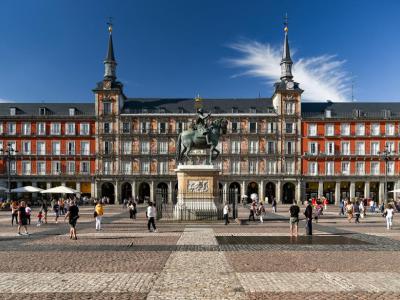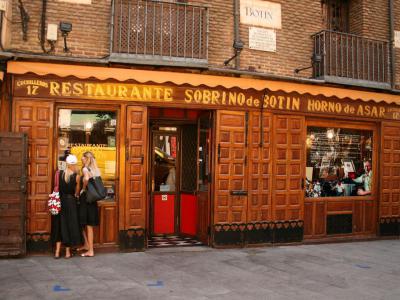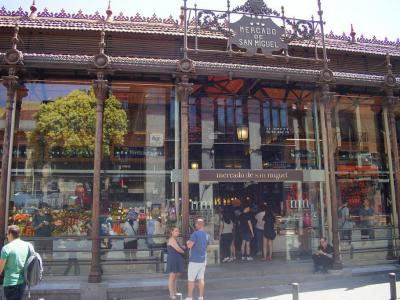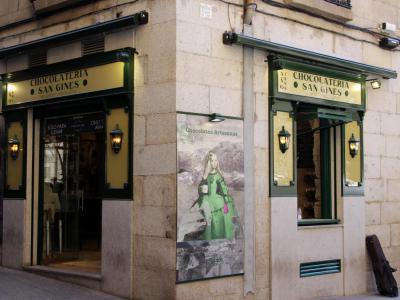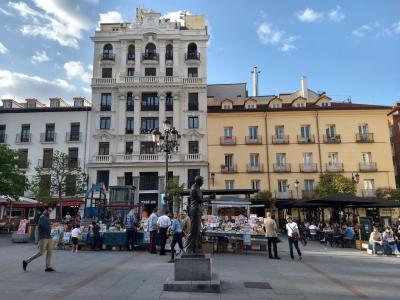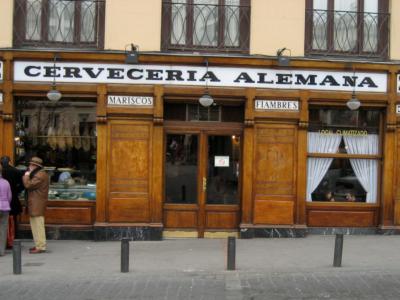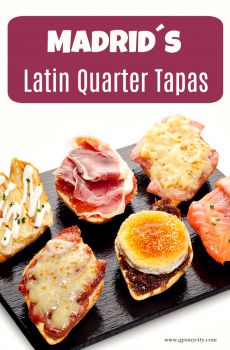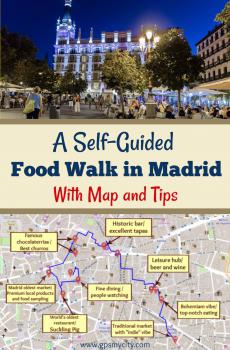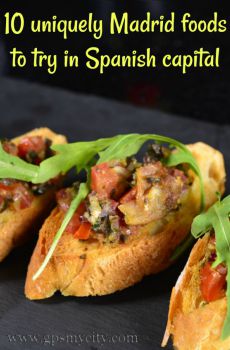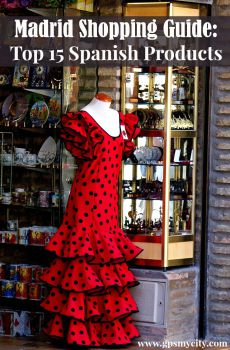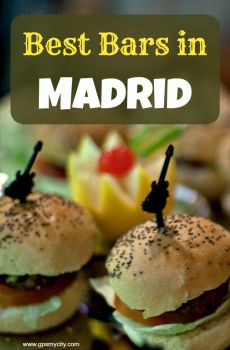Madrid Food Tour (Self Guided), Madrid
Spain is internationally reputed as a major gastronomic power and its capital city Madrid attests to this claim, being home to vibrant food markets and multiple establishments serving traditional Spanish food in a soul-warming atmosphere.
One of the iconic food destinations is Plaza Mayor, a bustling town square where you can savor traditional Spanish dishes. The square is home to numerous restaurants and cafes, offering a taste of Madrid's gastronomic delights.
For a truly historic dining experience, make your way to Botin, known as Europe's oldest restaurant. Established in 1725, this charming eatery serves succulent roasted suckling pig and lamb, prepared in wood-fired ovens, ensuring a taste of centuries-old culinary traditions.
For a taste of local flavors and fresh produce, visit Saint Michael's Market (Mercado de San Miguel). This indoor market offers a plethora of Spanish tapas, seafood, cheeses, and wines, making it a perfect spot for food enthusiasts to explore and sample the city's diverse cuisine.
Chocolateria San Gines is a sweet escape where you can indulge in Madrid's famous churros and rich, velvety hot chocolate. This cozy establishment has been satisfying sweet cravings since 1894.
A visit to the Gate of the Sun (Puerta del Sol), the bustling heart of Madrid, offers opportunities to try street food, such as Spanish sandwiches (bocadillos) and stuffed pastry (empanadas), while taking in the city's lively atmosphere. Nearby, Saint Anne's Square (Plaza de Santa Ana) boasts a variety of restaurants and cafes, offering both traditional Spanish dishes and international cuisine.
If you're in the mood for a different culinary experience, head to the famous German Beerhouse (Cerveceria Alemana) in Madrid, known for its hearty sausages, schnitzels, and of course, a wide selection of German beers.
Strolling along Huertas Street (Calle de Huertas), you'll encounter a myriad of tapas bars and restaurants, each offering a unique twist on traditional Spanish dishes.
Madrid's food scene is a culinary adventure well worth exploring. Be warned, though, that the delectable treats awaiting you on this self-guided gastronomic journey may leave you craving more of Madrid's delightful flavors and culinary prowess. But anyway – ¡Buen provecho! (Enjoy your meal!)
One of the iconic food destinations is Plaza Mayor, a bustling town square where you can savor traditional Spanish dishes. The square is home to numerous restaurants and cafes, offering a taste of Madrid's gastronomic delights.
For a truly historic dining experience, make your way to Botin, known as Europe's oldest restaurant. Established in 1725, this charming eatery serves succulent roasted suckling pig and lamb, prepared in wood-fired ovens, ensuring a taste of centuries-old culinary traditions.
For a taste of local flavors and fresh produce, visit Saint Michael's Market (Mercado de San Miguel). This indoor market offers a plethora of Spanish tapas, seafood, cheeses, and wines, making it a perfect spot for food enthusiasts to explore and sample the city's diverse cuisine.
Chocolateria San Gines is a sweet escape where you can indulge in Madrid's famous churros and rich, velvety hot chocolate. This cozy establishment has been satisfying sweet cravings since 1894.
A visit to the Gate of the Sun (Puerta del Sol), the bustling heart of Madrid, offers opportunities to try street food, such as Spanish sandwiches (bocadillos) and stuffed pastry (empanadas), while taking in the city's lively atmosphere. Nearby, Saint Anne's Square (Plaza de Santa Ana) boasts a variety of restaurants and cafes, offering both traditional Spanish dishes and international cuisine.
If you're in the mood for a different culinary experience, head to the famous German Beerhouse (Cerveceria Alemana) in Madrid, known for its hearty sausages, schnitzels, and of course, a wide selection of German beers.
Strolling along Huertas Street (Calle de Huertas), you'll encounter a myriad of tapas bars and restaurants, each offering a unique twist on traditional Spanish dishes.
Madrid's food scene is a culinary adventure well worth exploring. Be warned, though, that the delectable treats awaiting you on this self-guided gastronomic journey may leave you craving more of Madrid's delightful flavors and culinary prowess. But anyway – ¡Buen provecho! (Enjoy your meal!)
How it works: Download the app "GPSmyCity: Walks in 1K+ Cities" from Apple App Store or Google Play Store to your mobile phone or tablet. The app turns your mobile device into a personal tour guide and its built-in GPS navigation functions guide you from one tour stop to next. The app works offline, so no data plan is needed when traveling abroad.
Madrid Food Tour Map
Guide Name: Madrid Food Tour
Guide Location: Spain » Madrid (See other walking tours in Madrid)
Guide Type: Self-guided Walking Tour (Sightseeing)
# of Attractions: 8
Tour Duration: 1 Hour(s)
Travel Distance: 1.8 Km or 1.1 Miles
Author: emma
Sight(s) Featured in This Guide:
Guide Location: Spain » Madrid (See other walking tours in Madrid)
Guide Type: Self-guided Walking Tour (Sightseeing)
# of Attractions: 8
Tour Duration: 1 Hour(s)
Travel Distance: 1.8 Km or 1.1 Miles
Author: emma
Sight(s) Featured in This Guide:
- Plaza Mayor (Town Square)
- Sobrino de Botin (Europe's Oldest Restaurant)
- Mercado de San Miguel (Saint Michael's Market)
- Chocolateria San Gines
- Puerta del Sol (Gate of the Sun)
- Plaza de Santa Ana (Santa Ana Square)
- Cerveceria Alemana (German Beerhouse)
- Calle de Huertas (Huertas Street)
1) Plaza Mayor (Town Square) (must see)
Madrid’s grand and dramatic Town Square was initially dreamed up by King Felipe II, who, in the late 16th century, envisioned a more prestigious focal point for his new capital. The oldest building here, known as the Bakery House, dates back to 1590, though extensive rebuilding occurred after devastating fires in the 17th and 18th centuries. Interestingly, its eye-catching frescoes are relatively new, added as recently as 1992. Today, this building hosts the city’s tourist information center, welcoming visitors from morning until late into the evening. At the square’s center, you’ll spot a bronze equestrian statue of Felipe III, which has stood there since 1616.
Historically, this vast plaza-with a capacity of 50,000 people-hosted a wide range of events: royal coronations, religious ceremonies, theatrical productions, bullfights, and even public trials of heretics that ended dramatically with executions. Nowadays, the square remains a lively social hub, bustling with outdoor cafés, upscale restaurants, and plenty of tourists. Still, it hasn’t lost its old-world grandeur, continuing to host seasonal events like outdoor concerts, theatrical performances, festive Christmas markets, and a popular Sunday stamp and coin fair.
While many restaurants lining the plaza can be somewhat pricey and tourist-oriented, the square’s delightful atmosphere makes it an ideal setting for relaxing with a glass of Spanish wine and a delicious tapa. One culinary treat you shouldn’t miss here is Madrid’s signature calamari sandwich-crispy battered squid served fresh in a bun-best enjoyed with a refreshing cold beer.
Among the square’s standout eateries, Los Galayos is especially noteworthy. Established back in 1894, this historic restaurant is open every day until late, featuring multiple dining rooms and two inviting outdoor terraces. For a more casual experience, tucked in a charming alley just south of the square, you'll discover Casa Revuelta, an authentic local bar renowned for its “bacalao frito”-crispy, golden fried cod, simply irresistible.
Finally, just steps away on nearby Calle de Cuchilleros, sits Sobrino de Botín. Established in 1725, it proudly holds the Guinness World Record as the oldest continuously operating restaurant in the world.
Historically, this vast plaza-with a capacity of 50,000 people-hosted a wide range of events: royal coronations, religious ceremonies, theatrical productions, bullfights, and even public trials of heretics that ended dramatically with executions. Nowadays, the square remains a lively social hub, bustling with outdoor cafés, upscale restaurants, and plenty of tourists. Still, it hasn’t lost its old-world grandeur, continuing to host seasonal events like outdoor concerts, theatrical performances, festive Christmas markets, and a popular Sunday stamp and coin fair.
While many restaurants lining the plaza can be somewhat pricey and tourist-oriented, the square’s delightful atmosphere makes it an ideal setting for relaxing with a glass of Spanish wine and a delicious tapa. One culinary treat you shouldn’t miss here is Madrid’s signature calamari sandwich-crispy battered squid served fresh in a bun-best enjoyed with a refreshing cold beer.
Among the square’s standout eateries, Los Galayos is especially noteworthy. Established back in 1894, this historic restaurant is open every day until late, featuring multiple dining rooms and two inviting outdoor terraces. For a more casual experience, tucked in a charming alley just south of the square, you'll discover Casa Revuelta, an authentic local bar renowned for its “bacalao frito”-crispy, golden fried cod, simply irresistible.
Finally, just steps away on nearby Calle de Cuchilleros, sits Sobrino de Botín. Established in 1725, it proudly holds the Guinness World Record as the oldest continuously operating restaurant in the world.
2) Sobrino de Botin (Europe's Oldest Restaurant) (must see)
Dating all the way back to 1725, Sobrino de Botín holds the title of Europe’s oldest continuously operating restaurant-as recognized by the Guinness Book of Records. Originally called Casa Botín, it was founded by a Frenchman named Jean Botín and his wife. In the beginning, it functioned more like a tavern than a restaurant. But after Mrs. Botín passed away, her nephew took over, and the name changed to Sobrino de Botín-which means “Botín’s Nephew” in Spanish.
Step inside, and you'll find yourself in a maze of cozy, rustic dining rooms, where centuries of history seem to linger in the air. Botín is especially famous for two signature dishes: “cochinillo”, or roast suckling pig, and “cordero lechal”, tender roast lamb. The recipes haven’t changed over the years, and believe it or not, the wood-fired oven has never gone cold-it’s been burning continuously for three centuries.
The restaurant has also seen its fair share of famous faces. The legendary Spanish painter Francisco de Goya is said to have worked here as a young waiter while waiting to get into the Royal Academy of Fine Arts. And Ernest Hemingway was a loyal fan-he even gave the place a nod in the final pages of “The Sun Also Rises”, writing, “We lunched upstairs at Botín's. It is one of the best restaurants in the world. We had roast young suckling pig and drank rioja alta.”
If you’re thinking of visiting, be sure to book ahead. Tables fill up fast, and once you step through those doors, it’s easy to see why.
Step inside, and you'll find yourself in a maze of cozy, rustic dining rooms, where centuries of history seem to linger in the air. Botín is especially famous for two signature dishes: “cochinillo”, or roast suckling pig, and “cordero lechal”, tender roast lamb. The recipes haven’t changed over the years, and believe it or not, the wood-fired oven has never gone cold-it’s been burning continuously for three centuries.
The restaurant has also seen its fair share of famous faces. The legendary Spanish painter Francisco de Goya is said to have worked here as a young waiter while waiting to get into the Royal Academy of Fine Arts. And Ernest Hemingway was a loyal fan-he even gave the place a nod in the final pages of “The Sun Also Rises”, writing, “We lunched upstairs at Botín's. It is one of the best restaurants in the world. We had roast young suckling pig and drank rioja alta.”
If you’re thinking of visiting, be sure to book ahead. Tables fill up fast, and once you step through those doors, it’s easy to see why.
3) Mercado de San Miguel (Saint Michael's Market) (must see)
Saint Michael’s Market may not be Madrid’s largest, but it holds a unique place in the city’s history as the last surviving iron marketplace. Originally built in 1915, this striking single-level structure, encased in glass, served as a traditional neighborhood market for nearly a century. After an ambitious transformation in 2009, it emerged as a celebrated gastronomic destination, inspiring the rise of gourmet markets not just in Madrid, but across Spain.
Situated on the site of a former church-demolished in 1810 during the rule of Joseph Bonaparte-San Miguel now houses an impressive variety of food stalls. Here, you can savor freshly prepared dishes representing Spain’s diverse culinary traditions. If you’re unsure what to try, don’t hesitate to ask for a sample and find your new favorite flavor.
Beyond its tempting food offerings, the market features a wine bar, a vermouth bar, and even a flamenco venue. Live music performances add to the lively ambiance, making it much more than just a place to eat.
Tip: Before stepping inside, glance up at the fallen angel statue-“Accidente Aereo”-above the main entrance. While not as famous as the one in Retiro Park, it’s no less spectacular. And when nature calls, keep a receipt from one of your purchases handy; it might save you a restroom fee.
Situated on the site of a former church-demolished in 1810 during the rule of Joseph Bonaparte-San Miguel now houses an impressive variety of food stalls. Here, you can savor freshly prepared dishes representing Spain’s diverse culinary traditions. If you’re unsure what to try, don’t hesitate to ask for a sample and find your new favorite flavor.
Beyond its tempting food offerings, the market features a wine bar, a vermouth bar, and even a flamenco venue. Live music performances add to the lively ambiance, making it much more than just a place to eat.
Tip: Before stepping inside, glance up at the fallen angel statue-“Accidente Aereo”-above the main entrance. While not as famous as the one in Retiro Park, it’s no less spectacular. And when nature calls, keep a receipt from one of your purchases handy; it might save you a restroom fee.
4) Chocolateria San Gines
Recognized as an Historic Tourist Site by the City Council, this café has become an integral part of the Madrid's culture since its establishment in 1894, having gained fame for its offering of "chocolate con churros" – a combination of thick hot chocolate paired with deep-fried hoops of batter. This culinary delight serves as the perfect indulgence to cap off a night of extravagance, making San Ginés a popular destination for locals and visitors alike. In fact, it has become somewhat of a customary ritual for Madrileños to gather here after the clubs close, taking a moment to savor the treat before heading home for a quick shower and then off to work. However, the pleasure of this combination extends beyond the late hours of the night – it is equally satisfying for breakfast or as an afternoon pick-me-up.
Given the café's reputation, it is not uncommon to encounter queues during busy periods; nevertheless, the service is efficient and prompt. Whether you choose to enjoy your indulgence indoors or on the café's outdoor terrace, which extends onto a pedestrian street, you have the freedom to explore the diverse menu. In addition to the iconic "chocolate con churros", the menu offers an array of options including soft drinks, coffee, and a variety of other pastries. So, immerse yourself in this timeless café experience and savor the flavors that have captivated the hearts and palates of countless individuals throughout the years.
Given the café's reputation, it is not uncommon to encounter queues during busy periods; nevertheless, the service is efficient and prompt. Whether you choose to enjoy your indulgence indoors or on the café's outdoor terrace, which extends onto a pedestrian street, you have the freedom to explore the diverse menu. In addition to the iconic "chocolate con churros", the menu offers an array of options including soft drinks, coffee, and a variety of other pastries. So, immerse yourself in this timeless café experience and savor the flavors that have captivated the hearts and palates of countless individuals throughout the years.
5) Puerta del Sol (Gate of the Sun) (must see)
One of Madrid’s most popular gathering places, the Gate of the Sun is always buzzing with life. Historically, it marked the city’s original eastern entrance, where a gatehouse and castle once stood. Over the centuries, these structures gave way to churches, and in the late 19th century, the area transformed into the square we know today, becoming a hub of café culture and social activity.
Shaped like a half-moon, the area features a modern glass train station facing the statue of Carlos III on horseback at its center. Opposite, a red-brick government building, originally a post office from the reign of Carlos III, now houses the regional government. Later repurposed as the Ministry of the Interior, it gained its distinctive clocktower in 1866. This building, however, has a darker past-during the Franco regime, its basement cells were notorious for human rights abuses.
The Gate of the Sun itself has witnessed significant historical drama. On May 2, 1808, the Spanish uprising against French occupation began here, though the rebellion was ultimately quashed. In 1912, Prime Minister José Canalejas was assassinated in the square, and in 1931, the proclamation of the Second Republic was made from the Ministry’s balcony.
Today, it remains a focal point for festive events, bringing together locals and visitors alike. Nearby side streets offer a treasure trove of nightlife, with bars and clubs opening their doors late, creating a vibrant after-hours scene.
While here, you can also have a chance to eat like a local in a number of family-run restaurants, authentic taverns and tapas bars tucked away from the usual tourist paths. One such hidden gem is La Mallorquina, famed for its “napolitanas” and ring-shaped pastries, which can be enjoyed in an upstairs salon overlooking the square.
Shaped like a half-moon, the area features a modern glass train station facing the statue of Carlos III on horseback at its center. Opposite, a red-brick government building, originally a post office from the reign of Carlos III, now houses the regional government. Later repurposed as the Ministry of the Interior, it gained its distinctive clocktower in 1866. This building, however, has a darker past-during the Franco regime, its basement cells were notorious for human rights abuses.
The Gate of the Sun itself has witnessed significant historical drama. On May 2, 1808, the Spanish uprising against French occupation began here, though the rebellion was ultimately quashed. In 1912, Prime Minister José Canalejas was assassinated in the square, and in 1931, the proclamation of the Second Republic was made from the Ministry’s balcony.
Today, it remains a focal point for festive events, bringing together locals and visitors alike. Nearby side streets offer a treasure trove of nightlife, with bars and clubs opening their doors late, creating a vibrant after-hours scene.
While here, you can also have a chance to eat like a local in a number of family-run restaurants, authentic taverns and tapas bars tucked away from the usual tourist paths. One such hidden gem is La Mallorquina, famed for its “napolitanas” and ring-shaped pastries, which can be enjoyed in an upstairs salon overlooking the square.
6) Plaza de Santa Ana (Santa Ana Square)
Situated just a few blocks southeast of the iconic Gate of the Sun ("Puerta del Sol"), this expansive pedestrian square exudes a lively and occasionally boisterous ambiance. Its origins trace back to the reign of Joseph Bonaparte, brother of Napoleon, who oversaw its construction between 1808 and 1813. The square derived its name from the 16th-century Convent of Santa Ana, which previously occupied the area but was demolished to make way for this gathering place.
The square bears testament to its strong literary connections with monuments dedicated to two renowned Spanish writers. At one end stands a striking marble statue of Pedro Calderón de la Barca (1600–81), the playwright who was a prominent figure during the waning years of Spain's Golden Age of arts. Sculpted in 1878, the monument depicts scenes from four of Calderón's plays adorning its pedestal. At the opposite end, a statue of poet Federico García Lorca, erected in 1998 to commemorate the centenary of his birth, faces the Spanish Theatre ("Teatro Español"). Originally constructed in 1745, the theatre underwent restoration in 1980 following a devastating fire.
The square's ties to the performing arts extend further into history, as the theatre now occupies the site where the Corral del Príncipe once stood-a popular open courtyard venue for theatrical performances in 16th-century Madrid. These performances often fostered lively interactions, occasionally escalating into clashes between actors and audience members. Across from the theatre, the glass balconies of ME Madrid Reina Victoria, a luxurious hotel, offer a splendid view of the square.
The square's remaining two sides, as well as the adjacent streets, host a plethora of popular bars and restaurants. Notably, the classic Cervecería Alemana ("German Beerhouse"), established in 1904 and once a favorite haunt of author Ernest Hemingway, remains a bustling establishment, constantly bustling with customers. Just around the corner from the theatre, you'll discover Viva Madrid, a popular tavern frequented by the stylish and youthful, known for its captivating 19th-century ceramic tableaux. Here, you can savor a range of cocktails, classic tapas, and hearty Spanish main dishes.
Tip:
For an elevated experience, it is worth paying €8 to gain access to The Radio Rooftop (Wed, Thu: 4pm–1am; Fri, Sat: 4pm–3am; Sun: 4pm–2am), a cocktail bar on the top floor of the ME Madrid Reina Victoria hotel, that offers breathtaking views overlooking the square. Capture snapshots of local life bustling below or use a wide-angle lens to capture the broader cityscape beyond.
The square bears testament to its strong literary connections with monuments dedicated to two renowned Spanish writers. At one end stands a striking marble statue of Pedro Calderón de la Barca (1600–81), the playwright who was a prominent figure during the waning years of Spain's Golden Age of arts. Sculpted in 1878, the monument depicts scenes from four of Calderón's plays adorning its pedestal. At the opposite end, a statue of poet Federico García Lorca, erected in 1998 to commemorate the centenary of his birth, faces the Spanish Theatre ("Teatro Español"). Originally constructed in 1745, the theatre underwent restoration in 1980 following a devastating fire.
The square's ties to the performing arts extend further into history, as the theatre now occupies the site where the Corral del Príncipe once stood-a popular open courtyard venue for theatrical performances in 16th-century Madrid. These performances often fostered lively interactions, occasionally escalating into clashes between actors and audience members. Across from the theatre, the glass balconies of ME Madrid Reina Victoria, a luxurious hotel, offer a splendid view of the square.
The square's remaining two sides, as well as the adjacent streets, host a plethora of popular bars and restaurants. Notably, the classic Cervecería Alemana ("German Beerhouse"), established in 1904 and once a favorite haunt of author Ernest Hemingway, remains a bustling establishment, constantly bustling with customers. Just around the corner from the theatre, you'll discover Viva Madrid, a popular tavern frequented by the stylish and youthful, known for its captivating 19th-century ceramic tableaux. Here, you can savor a range of cocktails, classic tapas, and hearty Spanish main dishes.
Tip:
For an elevated experience, it is worth paying €8 to gain access to The Radio Rooftop (Wed, Thu: 4pm–1am; Fri, Sat: 4pm–3am; Sun: 4pm–2am), a cocktail bar on the top floor of the ME Madrid Reina Victoria hotel, that offers breathtaking views overlooking the square. Capture snapshots of local life bustling below or use a wide-angle lens to capture the broader cityscape beyond.
7) Cerveceria Alemana (German Beerhouse)
Right on the edge of Santa Ana Square sits the German Beerhouse-once a favorite haunt of none other than Ernest Hemingway, and a regular stop for stars of the day like Ava Gardner, who spent quite a bit of time in Madrid during the 20th century.
The brewery was founded back in 1904 by a group of German manufacturers, which explains the name. And while the city around it has evolved, this place has kept its old-school charm. Hemingway himself once called it “a good place to drink beer and coffee”-preferably, he added, in the company of “the most beautiful woman in the world.” His regular table still stands in the front right-hand corner, and honestly, it’s not hard to imagine him strolling in, ordering a drink, and watching the world go by.
Inside, you’ll find wooden beams, old hat racks, and black-and-white photos of past bullfights lining the walls. There’s nothing flashy here-just classic beer hall vibes and bowls of olives instead of bells and whistles.
The food is filling, the beer selection is wide-with options from Germany, Belgium, and Spain-and the service is fast and straightforward. If order a “caña”, that small glass of draught beer that’s perfect on a hot day, be mindful of those tapas plates. They may be tiny, but they add up quickly when the bill arrives.
The brewery was founded back in 1904 by a group of German manufacturers, which explains the name. And while the city around it has evolved, this place has kept its old-school charm. Hemingway himself once called it “a good place to drink beer and coffee”-preferably, he added, in the company of “the most beautiful woman in the world.” His regular table still stands in the front right-hand corner, and honestly, it’s not hard to imagine him strolling in, ordering a drink, and watching the world go by.
Inside, you’ll find wooden beams, old hat racks, and black-and-white photos of past bullfights lining the walls. There’s nothing flashy here-just classic beer hall vibes and bowls of olives instead of bells and whistles.
The food is filling, the beer selection is wide-with options from Germany, Belgium, and Spain-and the service is fast and straightforward. If order a “caña”, that small glass of draught beer that’s perfect on a hot day, be mindful of those tapas plates. They may be tiny, but they add up quickly when the bill arrives.
8) Calle de Huertas (Huertas Street)
As you wander along this street, take a moment to glance down at the ground, where brass letters have been set into the pavement, displaying quotes from renowned authors such as Galdós and Cervantes. The area, known as the Literary Quarter or the "neighborhood of Spanish writers", was once home to literary giants like Cervantes, Lope de Vega, and Quevedo during the 1600s.
Today, this bohemian and charmingly cobblestoned street offers a delightful mix of traditional taverns and trendy celebrity chef establishments. Brimming with thriving delicatessens and tapas joints, it offers visitors a chance to recharge and indulge in delectable bites and refreshing drinks. With practically every door along Huertas leading to a bar or restaurant that showcases both traditional and innovative takes on local cuisine, it's no wonder that even the most satiated stomachs find it difficult to resist the temptation of gluttony amidst such a gastronomic bombardment.
Notable architectural and historical points of interest include the late 18th-century neoclassical building on the left corner with calle León, which now houses the Royal History Academy ("Real Academia de la Historia"). It was originally constructed for the monks of El Escorial, who printed and sold their prayer books there. On the right corner, where calle del Príncipe intersects, you'll find the Santoña Palace, now serving as the Chamber of Commerce and Industry. Built in 1734 by Pedro de Ribera, it boasts a typically elaborate Baroque doorway.
Across the street, you'll spot the Casa Alberto tavern, distinguished by its red wooden frontage, providing a pleasant spot to enjoy a drink. It is worth noting that Cervantes himself lived in a house on this very site for a period of time during the early 17th century.
Tip:
Head to the cosy Blackbird Rock Bar (Tue-Sun: 8pm–3am) located at No. 22, a fantastic venue for those seeking a bluesy ambiance. If you're musically inclined, you can even showcase your talents during their monthly jam sessions. In addition to the music, the bar also offers a selection of cocktails, classic tapas, and hearty Spanish dishes to satisfy your cravings.
Today, this bohemian and charmingly cobblestoned street offers a delightful mix of traditional taverns and trendy celebrity chef establishments. Brimming with thriving delicatessens and tapas joints, it offers visitors a chance to recharge and indulge in delectable bites and refreshing drinks. With practically every door along Huertas leading to a bar or restaurant that showcases both traditional and innovative takes on local cuisine, it's no wonder that even the most satiated stomachs find it difficult to resist the temptation of gluttony amidst such a gastronomic bombardment.
Notable architectural and historical points of interest include the late 18th-century neoclassical building on the left corner with calle León, which now houses the Royal History Academy ("Real Academia de la Historia"). It was originally constructed for the monks of El Escorial, who printed and sold their prayer books there. On the right corner, where calle del Príncipe intersects, you'll find the Santoña Palace, now serving as the Chamber of Commerce and Industry. Built in 1734 by Pedro de Ribera, it boasts a typically elaborate Baroque doorway.
Across the street, you'll spot the Casa Alberto tavern, distinguished by its red wooden frontage, providing a pleasant spot to enjoy a drink. It is worth noting that Cervantes himself lived in a house on this very site for a period of time during the early 17th century.
Tip:
Head to the cosy Blackbird Rock Bar (Tue-Sun: 8pm–3am) located at No. 22, a fantastic venue for those seeking a bluesy ambiance. If you're musically inclined, you can even showcase your talents during their monthly jam sessions. In addition to the music, the bar also offers a selection of cocktails, classic tapas, and hearty Spanish dishes to satisfy your cravings.
Walking Tours in Madrid, Spain
Create Your Own Walk in Madrid
Creating your own self-guided walk in Madrid is easy and fun. Choose the city attractions that you want to see and a walk route map will be created just for you. You can even set your hotel as the start point of the walk.
Golden Mile Walking Tour
Similarly to 5th Avenue in New York City, Champs Elysee in Paris, or Bond Street in London, the Golden Mile is one of the wealthiest and most expensive neighborhoods of the Spanish capital. Forming part of Madrid's Salamanca district, this posh area is known for its upscale shopping, cultural attractions, and gastronomic delights.
One of the prominent local landmarks is Columbus Square... view more
Tour Duration: 1 Hour(s)
Travel Distance: 2.5 Km or 1.6 Miles
One of the prominent local landmarks is Columbus Square... view more
Tour Duration: 1 Hour(s)
Travel Distance: 2.5 Km or 1.6 Miles
Madrid Introduction Walking Tour
Welcome… to Madrid! A city where regal boulevards unfold like film reels, where iron balconies whisper old gossip, and where history has a flair for the dramatic. The Spanish capital is less a city, more a vast museum with a pulse, cradling centuries of European art, powdered baroque façades, and monuments that speak in old tongues if you listen close enough.
Madrid’s story begins long... view more
Tour Duration: 2 Hour(s)
Travel Distance: 3.8 Km or 2.4 Miles
Madrid’s story begins long... view more
Tour Duration: 2 Hour(s)
Travel Distance: 3.8 Km or 2.4 Miles
Miguel de Cervantes' Madrid Walking Tour
The name of the iconic Spanish writer Miguel de Cervantes is closely associated with Madrid. The author is known for a number of works, but his 1605 novel Don Quixote de la Mancha is often held as the first modern novel.
Despite being regarded as one of the fathers of modern literature, very little is known about Cervantes' early life. Born in 1547, he had spent some of his young years in... view more
Tour Duration: 1 Hour(s)
Travel Distance: 1.2 Km or 0.7 Miles
Despite being regarded as one of the fathers of modern literature, very little is known about Cervantes' early life. Born in 1547, he had spent some of his young years in... view more
Tour Duration: 1 Hour(s)
Travel Distance: 1.2 Km or 0.7 Miles
Buen Retiro Park Walking Tour
Buen Retiro-meaning “Pleasant Retreat”-is one of Madrid’s most beloved landmarks. Much like Central Park in New York or Hyde Park in London, this former royal escape has become the city’s most iconic green space, a peaceful oasis right in the heart of the Spanish capital.
Among its standout attractions is the Crystal Palace, a stunning 19th-century glass and iron structure that now... view more
Tour Duration: 2 Hour(s)
Travel Distance: 3.9 Km or 2.4 Miles
Among its standout attractions is the Crystal Palace, a stunning 19th-century glass and iron structure that now... view more
Tour Duration: 2 Hour(s)
Travel Distance: 3.9 Km or 2.4 Miles
Souvenirs Shopping Tour
Shopping for souvenirs in Madrid is an exciting and delightful experience for anyone visiting the vibrant Spanish capital. Indeed, it would be a pity to leave Madrid without having explored its specialty shops and bringing home something truly original. With this in mind, we've compiled a list of must-visit locations where you can find souvenirs, which are unique to Madrid and make for... view more
Tour Duration: 1 Hour(s)
Travel Distance: 1.0 Km or 0.6 Miles
Tour Duration: 1 Hour(s)
Travel Distance: 1.0 Km or 0.6 Miles
Ernest Hemingway's Madrid Walking Tour
Among the many writers who’ve spoken fondly of Madrid, few did so as passionately-or as famously-as Ernest Hemingway. A giant of 20th-century literature, Hemingway penned classics like “The Sun Also Rises”, “Death in the Afternoon”, “The Fifth Column”, “For Whom the Bell Tolls”, and “The Old Man and the Sea”. But beyond his books, he had a deep, lasting connection with the... view more
Tour Duration: 1 Hour(s)
Travel Distance: 2.5 Km or 1.6 Miles
Tour Duration: 1 Hour(s)
Travel Distance: 2.5 Km or 1.6 Miles
Useful Travel Guides for Planning Your Trip
Madrid´s Latin Quarter Tapas
This app is a description of bars and cafeterias of tapas and pinchos in the Latin Quarter of Madrid. Tapas and pinchos are generally bar snacks and finger foods, with pinchos generally originating from the Basque Country. The custom of tapas and pinchos-eating refers to eating at the bar, sometime...
A Self-Guided Food Walk in Madrid
The reputation of Spain as a major gastronomic power to reckon with goes a long way. The capital city of Madrid has a lot to offer visitors in terms of soul warming food experience. On this walk you will visit some of the city's most vibrant and lively food markets and other places serving...
10 Uniquely Madrid Foods to Try in Spanish Capital
There’s no better way to fall in love with a city than through its traditional cuisine. Complete meals, appetizers, beverages and sweets: all of them draw a path to a tourist heart. Madrid, the Spanish capital, has its very own unique and original dishes that can make a stay in this city a...
Madrid Souvenir Shopping Guide: Top 15 Spanish Products
They call Spain "magnificent" for a reason, as there're loads of fascinating stuff a visitor to the country might want to take home and share with family and friends. Luckily, in Madrid one can find nearly all that Spain is famous for - wine, food, fashion, arts, sports, etc. Good...
Top 12 Bars in Madrid
Madrid, the third largest city in Western Europe, is packed with an eclectic mix of bars that offer a scene for every style. In Spain’s Capital city, alcohol flows without end. Just take a walk down the streets of this vibrant city, and it seems as if every other building is a café or bar...
The Most Popular Cities
/ view all



